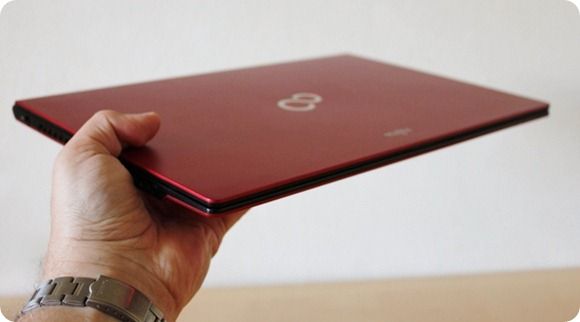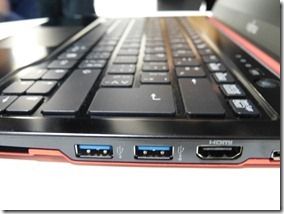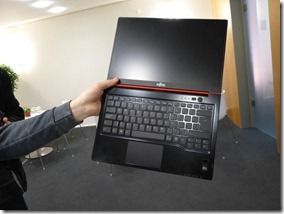I’m surprised that this has happened. The Fujitsu U772 has been outed in the flesh in a ‘pre-production’ review. We got hands-on back at CeBIT when the model name was unknown and we enjoyed one of the thinnest, best-looking Ultrabooks so far. 15.9mm and amazingly small for a 14” laptop.

Is it the incredibly thin bezel that makes it look so modern and tasty or is the overall chic look and ultra-thin lines?
DinSide hare the lucky site to have the pre-production sample in their hands and have published a reasonable run-down of the features which include a 3G/4G option, seldom seen on Ultrabooks. The Ivy Bridge Core i5-3427U at 1.8Ghz is inside with a 128GB SSD. The are HDD options and RAM can either be 4GB or 8GB. We’ve put all the data we can find in our database.
Unfortuantely the 14” screen is a 1366×768 part in the review sample which is going to be very disappointing for some. We can only hope for higher resolution options.


Pics from our hands-on at CeBIT in March – More here.
Performance and Battery Life
Without details on the size of the battery it’s difficult to tell how efficient this 2nd-gen Ultrabook is but test results are showing up to 8hrs battery life. For a 1.5KG device it’s not a huge step forward but then we weren’t expecting too much in-use improvements. Normal use battery life figures are said to be between 6 and 7hrs.
We’ll keep an eye out for official specs for you. Expect to see hands-on with this at Computex in June.
P.S. Note the docking port which could turn this into one of the best desktop Ultrabooks so far.
Our Gallery is here. Our hands-on video below.











The Passmark results for HD 4000 is only showing 30% improvement. That is very poor. It’ll end up being barely faster than 35W HD 3000 parts. I hope that’s not true and it’ll be fixed in the final version.
I guess it depends what drivers they’re running. Big scope for improvement there I’d say.
30% gain is not a big deal at all in the graphics world. Not only the gains easier to come by thanks to the nature of the code being “embarassingly parallel” and extremely sensitive to memory bandwidth, you need those sorts of gains to make games playable.
The games that don’t need the gains and run fine isn’t demanding enough and probably even fine with HD Graphics, not even the 3000 version. The games that really need the gains need big gains. I’d like to see at least 30% gain on top of what’s shown here for a total of 70%.
Great connectivity options, LOVE, LOVE, LOVE those insanely thin bezels! Is that the thinnest screen bezel of any laptop? (It HAS to be.)
Battery increases aren’t going to come with Ivybridge and neither are significant CPU increases; I think the most exciting thing about Ivybridge is the drop in price for the Sandybridge laptops, some of the thinner bezel laptops coinciding with the Ivybridge launch, some of the new summer form-factors, decreases in cost, slow perfection of SSD Caching mechanisms, and just a lot of “little things” like improved cooling designs and improved keyboards and trackpads as MFGRs learn from v.1 of ultrabooks.
The true V2 Ultrabook platform is really about MFGR refinement more than any dramatic platform improvements coming from Intel. (Haswell will bring that in spades (fingers crossed) but it’s way too far off to wait for.)
Adam
CPU will end up being ~20% faster, making the top i7 U parts pretty close to 35W Sandy Bridge ones. By “significant” I assume you are thinking 40-50% or better but that rarely happens and 20% is a decent gain in a year.
I just hope the graphics ends up being on par or close to 2x faster, not the piss poor 30% shown on this article.
You got your points right. The CPU and battery is merely evolutionary but at least with convertibles and hybrids we’ll get out of the “copy of MBA” criticism with 1st gen Ultrabooks. Then we can have real fun. :)
Intel GPU benchmarks vary greatly. I’ve seen exact same spec laptops from different manufactures have wildly different results. There are things you just can’t account for like custom throttling some manufactures implement & it’s only going to get more complicated going forward.
While IB GPU improvements are nice, too much has been made of them. Haswell next year is when Intel says the huge improvement will be seen (from 16 to 40 Execution Units).
Looks great. I like the thinness, the port selection, and fitting a 14″ screen in a smaller form factor.
Screen resolution not so good.
I’m guessing that an SSD version will probably come in at around US$1,500 here, so it will be one of the pricier ultrabooks.
I’ve heard that it’s more difficult to fit a high res screen in a laptop with a very thin bezel. I have no idea why, or even if it’s true – but if it is, it could be the reason behind the pedestrian 1366×768 resolution. While I love thin bezels, there is no way I’m going to buy a laptop with this resolution when others like ASUS are offering 1080p from their 15″ down to the 11″ ultras.
Personally I’m not that fond of all the ports. It’s great for the people that travel and use their computers for presentations and so on, but most of the time they just gather dust and take up place that could be USB slots.
It’s possible that LG’s Shuriken product, which I think is the screen being used here, doesn’t come in that high resolution yet. (Or is very expensive.) Thin bezel or high PPI is the choice!
Tough choice. I think I’m leaning towards high res, but it’s not a given by any means. There’s certainly a maximum where the bezel is just too thick. I’m keeping my fingers crossed that at least one of my favorite ultrabooks will get it right.
That kinda makes sense. The Full HD Asus Zenbook Prime has pretty thick bezels.
I’ve just noticed the bezel thickness. That’s insane! And this Fujitsu has a unique look not like MBA.
I agree – the bezel is too thick on the Zenbook, but considering they are updating screen res and keyboard I might look past it.
I’d also prefer not to have a MBA clone. Personally I find the Series 9 and the U300s to be the best looking ultras out there. I just hope they will be able to keep up with the Zenbook in the other areas.